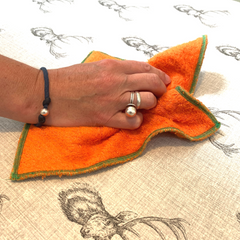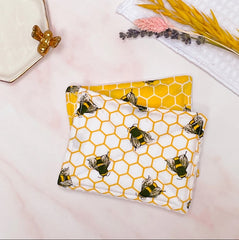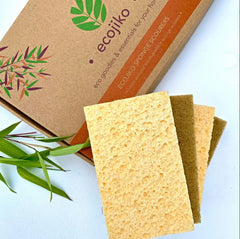Ever thought of a kitchen sponge alternative? If you haven’t yet, you might do after reading this. You may not be aware, but your green and yellow kitchen sponge is the grimiest thing in your house; it’s been scientifically proven to have more germs than your toilet.
If that isn’t scary enough, there’s more bad news. They’re also harmful to the environment; they’re made from synthetic plastic fibres that pollute waterways and aren’t biodegradable, so they’re sitting in landfills around the world.
It’s not all doom and gloom though, there are some awesome eco-friendly sponge alternatives out there to help you clean your kitchen; so what can you use instead of a plastic kitchen sponge?
Here are 7 alternatives to your kitchen sponge:
#1: Unsponge
Handmade, durable and an awesome sponge alternative; once you unsponge, you won’t go back. The Unsponge is the ultimate eco-friendly sponge - washable, reusable and completely compostable; it will last for loads of washes, saving money on disposables in the long-run.
Above: Instead of sending micro-plastics down the drain, try an Unsponge like this one by honeyco
#2: Swedish dishcloths
The Swedes are smart people; not only did they come up with Ikea but they also invented the Swedish dishcloth. Originally invented by a Swedish engineer in 1949, the Swedish dishcloth works like a dream in the kitchen. It’s made from 70% wood cellulose and 30% cotton making it long lasting and biodegradable. It absorbs 15 times it’s weight so is a great alternative to kitchen sponges, it dries quickly which means less bacteria and can be washed around 200 times so it’s extremely durable. If you haven’t discovered the Swedish dishcloth yet then you’ve been missing out - definitely one of our favourite eco-friendly products.
Above: Swedish dishcloths are made of 70% wood cellulose and 30% cotton, and are completely compostable.
#3: Coconut Washing up brush
Natural dish brushes are a great alternative to kitchen sponges. The bristles on this dish brush are made from coconut fiber- tough enough to shift tough grease and build up, but soft enough to be used on non-stick pans and glassware. With a long handle made from sustainably sourced wood, you'll barely even get your hands wet!
Above: This coconut washing up brush is made from coconut husk that would otherwise have gone to waste.
#4: Bamboo dishbrush
A great alternative to kitchen sponges, we've seen the bamboo dish brush in many stylish zero waste kitchens! Once the bristles wear out, you can replace the dish brush head and slot in the new head. Then just put the used dish brush head in the compost to decompose.
Above: Switch to a bamboo dish brush with a replaceable head, to save money and reduce waste even more!
#5: Bamboo dish cloths
Bamboo dish cloths are a great sponge alternative. They’re strong, absorbent and substantially more eco-friendly. Each bamboo sheet can be washed and reused about 100 times making them perfect for spills, dust and so much more.

Above: Bamboo dish cloths are the perfect, washable, reusable, zero waste option to replace typical kitchen roll
#6: Cellulose Sponge Scourers
These sponge scourers look the most like your plastic kitchen sponge - but they're actually 100% biodegradable! They're made from sisal (which comes from the agave plant) and cellulose, which comes from wood pulp. Not only are they better for the environment - these ecofriendly sponges don't absorb smells like your plastic kitchen sponge, plus they'll last a lot longer!
Above: Cellulose sponge scourers are 100% compostable, plus they last alot longer!
#7: Bamboo Pot Scrubbers
Need to do some heavy-duty scrubbing? Bamboo pot scrubbers are a great alternative to synthetic scourers. And they're not just handy for the dishes - you can actually use these eco-friendly dish scrubbers to clean everything from muddy boots, vegetables, nails or even brushing beards!
Above: Switch to sustainable bamboo with these cute pot scrubbers
Use these 7 eco-friendly alternatives to replace your kitchen sponge; they’ll keep your kitchen sparkling clean, preventing germs and bacteria from spreading, as well as benefit the planet by saving all those kitchen sponges going to landfill and polluting our waterways.
Are you ready to ditch your plastic sponge? Check out our range of kitchen sponge alternatives
KITCHEN SPONGE ALTERNATIVES - FAQ
What can you use instead of a sponge?
Here are 7 alternatives to your kitchen sponge: #1: Unsponge. #2: Swedish dishcloths. #3: Coconut washing up brush. #4: Bamboo dishbrush #5: Bamboo dishcloths. #6: Cellulose sponge scourers. #7: Bamboo pot scrubbers.
How often should you throw out a sponge?
Experts recommend throwing out your dishwashing sponge every 2 weeks - all the more reason to switch to reusable!
Are kitchen sponges bad for the environment?
Green-and-yellow plastic kitchen sponges are harmful to the environment; they’re made from synthetic fibres that pollute waterways and aren’t biodegradable, so they’re sitting in landfills around the world.
How long do sponges take to decompose?
As green-and-yellow kitchen sponges are made of plastic, they can take hundreds of years to decompose. What's worse, even before they're thrown out, they shed microfibres into our waterways.
Are there biodegradable sponges?
There are lots of natural alternatives to your plastic kitchen sponge that will biodegrade naturally. Our favourites are sisal, which comes from the agave plant in Mexico, and coconut fibres - the unused part of the coconut, which would otherwise go to waste.







Useful info.
We have often wondered about alternatives. You didn’t mention natural sea sponge; we tried it once but this is surely completely unsustainable & environmentally destructive if expanded into the industrial level of extraction rates needed. The problem is also that the part abrasive plastic sponges are very effective at removing tough deposits that most cloths or scrubbing brushes (plastic or natural) struggle to do. We clearly have been keeping our sponges too long, like months, to get the most out of them! That said we do rinse items after washing. Sponges do get very manky, fit only for floor spills. You used to see the quite effective aluminium “swarf” pads quite often, which would seem to be recyclable but I don’t know how they are made – i.e. do they contain any plastics to hold them together? It will be good to see the back of the green abrasive faced sponges as they are excellent for ruining plastic bath, sink & worktop surfaces, as they scratch the finish so that it always gets & holds dirt. The green & other colours (graded by abrasiveness) are used to clean & prepare surfaces for paint, varnish & other industrial purposes. Hopefully this usage will also be reduced or stopped eventually.
Re. bedsheets etc., how many people actually have pure Linen? As lovely & Eco as Linen is, Polycotton rules that market. Of course reusing the polycotton is a good thing anyway. A lot of our old clothes & sheets eventually get used in my workshop. Useful for paint & glue spills, oily machinery & hands etc. So many of our clothes contain or are totally artificial plastic fibres. It’s often hard to find an item you like that is totally natural. Even “simple” cotton jeans now have stretch plastics in them which just adds to the problem of cotton production (vast water use) & recyclability.
We will be trying out your recommendations.
Thanks